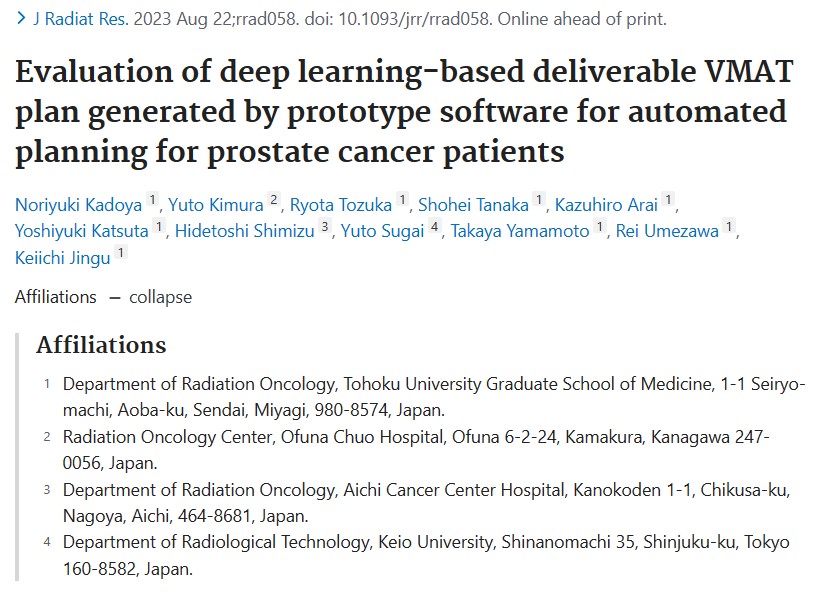A paper on AI automated treatment planning for IMRT has been published online
Research on automatic treatment planning technology for intensity-modulated radiation therapy (IMRT) jointly developed by Tohoku University Graduate School of Medicine, Department of Radiation Oncology, and our company has been published online in the English academic journal “Journal of Radiation Research”. This paper is a retrospective evaluation of our AI automatic planning prototype software at Tohoku University Hospital, which is a joint research destination.
Evaluation of deep learning-based deliverable VMAT plan generated by prototype software for automated planning for prostate cancer patients
Noriyuki Kadoya, Yuto Kimura, Ryota Tozuka, Shohei Tanaka, Kazuhiro Arai, Yoshiyuki Katsuta, Hidetoshi Shimizu, Yuto Sugai, Takaya Yamamoto, Rei Umezawa, Keiichi Jingu
論文掲載ページ

Summary of this paper
This study aims to evaluate the dosimetric accuracy of a deep learning (DL)-based deliverable volumetric arc radiation therapy (VMAT) plan generated using DL-based automated planning assistant system (AIVOT, prototype version) for patients with prostate cancer. The VMAT data (cliDose) of 68 patients with prostate cancer treated with VMAT treatment (70-74 Gy/28-37 fr) at our hospital were used (n = 55 for training and n = 13 for testing). First, a HD-U-net-based 3D dose prediction model implemented in AIVOT was customized using the VMAT data. Thus, a predictive VMAT plan (preDose) comprising AIVOT that predicted the 3D doses was generated. Second, deliverable VMAT plans (deliDose) were created using AIVOT, the radiation treatment planning system Eclipse (version 15.6) and its vender-supplied objective functions. Finally, we compared these two estimated DL-based VMAT treatment plans-i.e. preDose and deliDose-with cliDose. The average absolute dose difference of all DVH parameters for the target tissue between cliDose and deliDose across all patients was 1.32 ± 1.35% (range: 0.04-6.21%), while that for all the organs at risks was 2.08 ± 2.79% (range: 0.00-15.4%). The deliDose was superior to the cliDose in all DVH parameters for bladder and rectum. The blinded plan scoring of deliDose and cliDose was 4.54 ± 0.50 and 5.0 ± 0.0, respectively (All plans scored ≥4 points, P = 0.03.) This study demonstrated that DL-based deliverable plan for prostate cancer achieved the clinically acceptable level. Thus, the AIVOT software exhibited a potential for automated planning with no intervention for patients with prostate cancer.